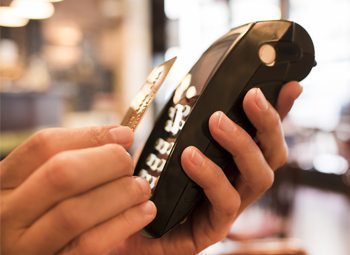Consumers are swiping less at registers this holiday season, in favor of the chip-embedded credit and debit cards working their way into wallets nationwide.

The chip-embedded cards are harder to hack, and banks and card issuers are sending them to customers in the hopes they cut down on fraud.
A big reason for the recent push to issue the chip cards is an Oct. 1 deadline, known as the EMV liability shift, that began assigning liability to the least chip card compliant of the parties involved in a fraudulent transaction – usually either the issuer or the merchant.
Merchants have been scrambling to install new point-of-sale terminals that accept chip cards to assure they are not liable for fraud, especially during their busiest shopping season.
At Indulgence Chocolatiers, a chocolate shop that has stores in Walker’s Point, Wauwatosa and Shorewood, the point-of-sale terminals were all less than three years old, but needed to be replaced with the new regulation, said owner Julie Waterman.
“We completely understand and we have our own practices to ensure security, but we were a little frustrated that there’s this new change that requires us to purchase all new equipment,” she said.
The bill: About $2,000 among the three stores.
Employees are also working with customers to teach them how to use the chip cards in the newer terminals, Waterman said.
“They are having to tell people how to do it, because it’s just different,” she said. “We completely understand why the transition is happening so we don’t feel that it’s unreasonable at all, but it does require a little bit more of a store.”
Waterman is also the board president of Local First Milwaukee, an alliance of local businesses and nonprofits. Its approximately 300 business members are working on transitioning their terminals, but it hasn’t been a particular issue that’s come up among the group, she said.
The organization represents about 400 independent operators and chains across the state, as well as about 200 wholesalers, suppliers, vendors and others.
Grocers have not experienced any significant problems with using the chip card terminals that they’ve reported to the WGA, he said.
“Certainly the industry and our members follow it because anything that can be done to improve the security of a customer’s card is real high on the list,” Scholz said.
But the rollout of chip cards by banks has been more gradual, he said.
“I’m not an expert in what the banks and the credit card people do, but they’re not turning this around,” Scholz said. “Our concern is that while we were forced to hit this Oct. 1 deadline, it’s out of our control.”
That’s because many banks and card issuers are waiting until cards expire to issue new ones, essentially accepting the fraud liability for the time being because of the high cost of massive card replacement, said Steve Platt, executive vice president of fraud and identity at Experian.
“The rollout of EMV is just starting and it won’t be done for another year or two,” Platt said. “The bank issuers are busy issuing new cards, credit and debit, and that is far from done yet. For the retailers, while some of them have installed new terminals for EMV, that process is still underway.”
As consumers begin using the more secure chip cards for in-store transactions, fraudsters are targeting online transactions, he said. Compounding that is the fact that consumers are doing more and more of their shopping online.
“It’s no surprise that the volume of online sales activity is increasing year-over-year,” Platt said. “We’re seeing volumes anywhere from 10 to 40 percent higher year-over-year. Of course, online merchants, they (accept) the liability for fraud.”
Experian has been working with online merchants to prepare for the increased fraud attempts by beefing up security, he said.
“If you are a typical retailer, your fastest path to fraud protection is of course to upgrade your fraud terminals and accept every EMV compliant card that consumers pay with,” Platt said. “If you’re an online merchant, you always had the liability, so that hasn’t changed with EMV. What has changed is the degree to which fraudsters will now target online transactions.”